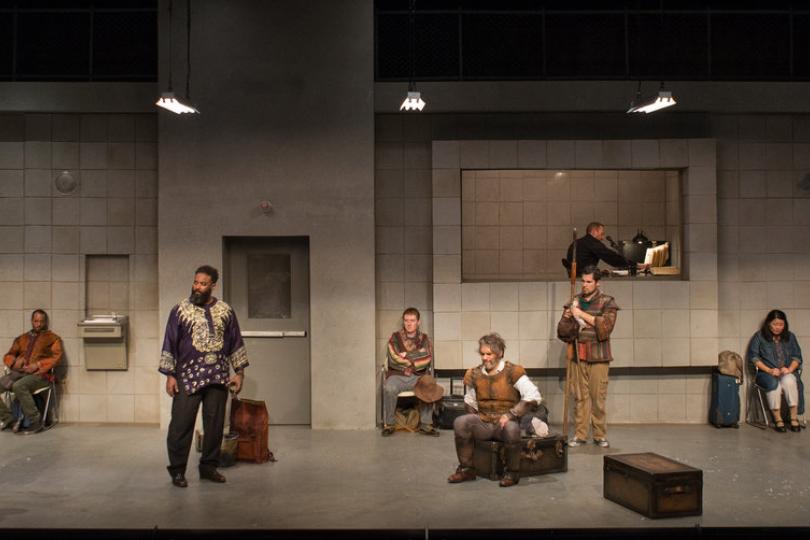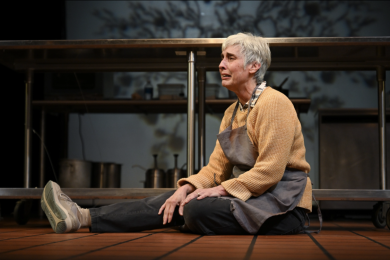The Dream of All

The director’s concept for any theatrical production is a valuable requirement. It informs the cast and creative team how the story is to be told and is what makes one production different and unique from another. Although concepts are required, there is nothing to guarantee if a concept will it be deemed “visionary” or “gimmicky.” Theatre Latté Da’s Man of La Mancha wraps itself in a bold concept which becomes the dominant feature of the production.
The musical begins with its protagonist, Miguel de Cervantes (the author of Don Quixote, upon which Man of La Mancha is inspired), being tossed into a prison vault to await trial by the Spanish Inquisition. While he waits for his official trial, Cervantes is unofficially tried by his fellow prisoners on the charges of being an idealist, poet, and honest man. Enlisting the help of the inmates, Cervantes decides to plead his case through the telling of the story of Alonso Quijano (the fictional protagonist of Cervantes’ novel Don Quixote).
In the opening number, “Man of La Mancha” (which left the full-house hooting and hollering in approval), the audience immediately learns that Quijano has lost his mind and adopted the personality of Don Quixote, a chivalrous wanna-be knight. The majority of the musical is spent following Quixote, occasionally interrupted by the actions of the prison vault: constantly reminding Cervantes and the audience that Cervantes is still on trial by the Inquisition and his peers. These interruptions bring the real tension to Theatre Latté Da’s production.
In its traditional staging, the prison vault of Man of La Mancha is a 1600s Spanish prison vault. Here, however, director Peter Rothstein has decided to juxtapose Cervantes’ narrative in a twenty-first century American prison against Quixote’s narrative in the seventeenth century Spanish countryside. This juxtaposition, reliant on costumes and props, begs the question: why impose such a drastic concept on a show that has proven itself to be well-crafted and does not require any crutches on which to stand?
At the center of Man of La Mancha is the discrepancy between seeing life for what it truly is versus seeing life as one decides to see it: the “Impossible Dream.” And this is what theatre is, is it not? An escape? No matter the staging, the audience should leave contemplating this theme: how best to view life. Realistic or idealistic? Rothstein’s decision to cram Man of La Mancha and it’s consciously diverse cast into the twenty-first century narrows the audience’s focus and forces them to consider this theme, not personally, but as it pertains to modern American culture and the ever-topical issues around acceptance of diversity. Will we, the audience, choose to bury ourselves in the reality of the rifts happening in the world? Or will we continue to reach toward that idealistic dream of what life could be? And which view is better?
Because of the specific focus of Theatre Latté Da’s questions and the concept through which it is presented, I struggled to empathize with Cervantes/Quijano/Quixote. He became less of a character and more of a means by which to communicate a point: a prop. However, this did not detract from the commanding and multi-faceted performance of Martín Solá in the role. Mr. Solá’s “The Impossible Dream” gave me chills and drew rousing cheers and lasting applause from the audience.
Despite Mr. Solá’s incredible feat of performing three interwoven characters, it was Meghan Kreidler’s portrayal of Aldonza, the self-proclaimed kitchen slut and target of Quixote’s affection, that stole the show for me. In particular, her song “Aldonza” was captivating and spectacular--I think I forgot to breathe until it was over.
Jon-Michael Reese as the Padre was something to behold. His gorgeous “To Each His Dulcinea” was like honey and I wanted to give his comedic chops in “I’m Only Thinking of Him” a standing ovation. Milking their few lines for all their worth, Dan Hopman’s winking Captain and Sara Ochs’ exasperated Maria made me bark with laughter.
The austere, concrete, contemporary set, designed by Michael Hoover, is the driving force behind Mr. Rothstein’s concept and reinforces the theme of seeing life as it is or as we choose to see it. Just as Cervantes is occasionally reminded he is on trial, the set, with the assistance of Marcus Dilliard’s lighting design, reminds the audience that they are simultaneously watching a play and suspending disbelief: choosing life as they decide to see it.
For how much the concept confounded me before, during, and after the show, I wish it had been taken further with Rich Hamson’s costumes and Abbee Warmboe’s props. Although the costumes and props were successful in their responsibility to the story, I would love to know why these aspects of the show maintained the traditional 1600s Spain design. Why not keep everything contemporary?
Part of the reason may be due to the distinctly Spanish-flavored score. No matter what concept is imposed on the piece, the score cannot be altered and so it is best to work with it instead of around it. This being said, Denise Prosek’s band did an outstanding job filling the stage and I could have sworn there were more than just four pieces behind the set.
It is overstated that shows are done because of their relevance to today. Man of La Mancha as it is written isn’t topical, but it is Theatre Latté Da’s concept that forces its relevance. And despite the standing ovation at curtain call, I felt I had spent more time during the show justifying this forced concept than appreciating it.
But the final moments of the show, more than any other aspect of the production, stick with me--and perhaps this makes the concept worth the hours I spent examining it. Once Cervantes has been led away to be judged by the Spanish Inquisition, the contemporary, diverse ensemble sings directly to the audience. The melody is clear, but the words are foreign. Slowly, the languages all become one and the message is clear: “The Impossible Dream” is the dream of all cultures, races, and backgrounds and it is only when we lose faith in that idealist beacon that we falter and stumble in reality.




